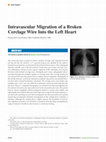Papers by Francesco Leonardi
Arthroplasty Today, 2015
There is still debate over the limits of age and bone stock quality of patients on whom to use an... more There is still debate over the limits of age and bone stock quality of patients on whom to use an uncemented straight stem coated with hydroxyapatite (HA). We studied a group of 244 patients with a displaced intracapsular fracture of the femoral neck who underwent cementless hemiarthroplasty or total hip arthroplasty. 143 patients were reviewed at the two-year follow up. A fully HA-coated stem for intracapsular hip fracture results in a satisfactory return to pre-injury mobility and a low complications rate. The advantage reported in the literature of a low mortality rate with use of an un-cemented implant in elderly patients was shown to be greater still on finding an immediate primary stability and rapid osteointegration of the implant.

Orthopedics, 2014
This article describes a patient in whom a broken cerclage wire migrated from the left hip into t... more This article describes a patient in whom a broken cerclage wire migrated from the left hip into the left ventricle. A 71-year-old woman was admitted to the authors' hospital for preoperative examination before femoral hernia repair. Chest radiograph showed a metallic wire in the left ventricle. Twenty-four years earlier, she had a revision arthroplasty. During revision surgery, fragments of the osteotomy were fixed to the femur with multiple cerclage wires. During the past 5 years, radiographic follow-up showed progressive multiple ruptures of cerclage wires. The cerclage wiring was not removed because the patient had no related clinical symptoms. Radiograph of the left hip showed a well-fixed cemented acetabular ring and an uncemented femoral stem with a healed trochanteric osteotomy. All cerclage wires were broken into multiple parts, and it was very difficult to determine which part had migrated into the heart. Thoracic computed tomography scan showed wire that had migrated i...
Joints, 2017
Chronic dislocation of the knee is a rare condition due to a diagnostic mistake during emergency ... more Chronic dislocation of the knee is a rare condition due to a diagnostic mistake during emergency assessment. Usually, dislocation obliges the surgeon to carry out a broad assessment, with vascular and neurological examination, and a thorough assessment of joint injuries. The immediate and stable closed reduction can resolve neurovascular compression. The most serious late sequela is joint instability with impairment of ambulation and patient's autonomy. Treatment of neglected knee dislocation is surgical, that is, arthrodesis or arthroplasty, the latter representing the treatment of choice. The case described herein appears unique because of the clinical and radiographic features. Interestingly, over the years, the neurovascular bundle has inadvertently adapted to the posterior femur displacement without secondary damage.

Journal of Orthopaedics and Traumatology, 2013
Background Torsional malalignment syndrome (TMS) is a well defined condition consisting of a comb... more Background Torsional malalignment syndrome (TMS) is a well defined condition consisting of a combination of femoral antetorsion and tibial lateral torsion. The axis of knee motion is medially rotated. This may lead to patellofemoral malalignment with an increased Q angle and chondromalacia, patellar subluxation and dislocation. Conservative management is recommended in all but the most rare and severest cases. In these cases deformity correction requires osteotomies at two levels per limb. Materials and methods From 1987 to 2002 in our institution three patients underwent double femoral and tibial osteotomy for TMS bilateral correction (12 osteotomies). All patients were reviewed at mean follow-up of 16 years. Results At final follow-up no patients reported persistence of knee or hip pain. At clinical examination both lower limbs showed a normal axis and a normal patella anterior position. Pre-operative femoral version measurement showed an average hip internal rotation of 81.5°(range 80°-85°) and average hip external rotation of 27.2°(10°-40°). Thigh-foot angle measurement showed an average value of 38.6°(32°-45°). At final follow-up femoral version measurement showed an average hip internal rotation of 49°(range 45°-55°) and average hip internal rotation of 44.3°(20°-48°) (Figs. 1, 2, 3, 4, 5, 6). Thighfoot angles measurement showed an average value of 21.6°(18°-24°) outward. Conclusion We recommend a clinical, radiographical and CT scan evaluation of all torsional deformity. In cases of significant deformity, internally rotating the tibia alone is not sufficient. Ipsilateral outward femoral and inward tibial osteotomies are our current recommendation for TMS, both performed at the same surgical setting.

HIP International, 2016
Purpose The direct anterior approach (DAA) for total hip arthroplasty (THA) is claimed to be as e... more Purpose The direct anterior approach (DAA) for total hip arthroplasty (THA) is claimed to be as effective but less invasive than the conventional posterior approach (PA). However, the higher risk of femoral fracture and soft tissue damage cannot be underestimated. The present authors believe that the difficult femoral exposure and the surgeon's knowledge of possible complications related to femoral preparation may result in a higher rate of undersized stems when compared to PA, even when a short femoral component is employed to minimise these risks. Methods A retrospective study was performed to compare the effective adherence of surgical sizing to preoperative planning in a series of 112 short stem THAs, of which 59 were implanted through PA and 53 through DAA without intraoperative imaging, by a single surgeon skilled in both techniques. Results the frequency of stems smaller than expected was 3-times higher with DAA than with PA (54.72% vs 16.95%, p<0.001), while the frequ...

Uploads
Papers by Francesco Leonardi